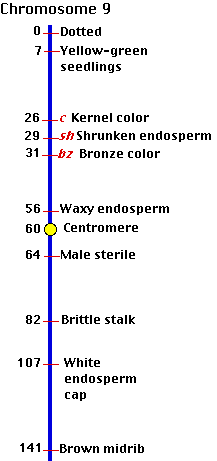The Evidence of Creighton and McClintock
In 1932, the geneticists Harriet Creighton and Barbara McClintock provided an elegant demonstration that the recombination of genes linked on a chromosome requires the physical exchange of segments of the chromosome with its homologous partner.
 During their studies of linkage in corn, they developed a strain of corn that had one chromosome (number 9 of 10 pairs) with two unusual features:
During their studies of linkage in corn, they developed a strain of corn that had one chromosome (number 9 of 10 pairs) with two unusual features:
- a knob at one end of the chromosome and
- an extra piece at the other. The extra piece of chromosome (shown in gray in the figure below) was the result of a translocation that had occurred at an earlier generation.
Here was an organism with a rare chromosomal aberration that made it possible to distinguish two homologs from each other under the microscope. Furthermore, this unusual chromosome carried the dominant allele for colored kernels (C) and the recessive allele for waxy endosperm (wx). Its normal-appearing mate carried the recessive allele for colorless kernels (c) and the dominant allele for normal (starchy) endosperm (Wx).
Thus the plant was a dihybrid for these two linked traits and, in addition, one chromosome of the pair was visibly marked at each end.
Creighton and McClintock reasoned that this plant would produce 4 kinds of gametes:
- the parental kinds
- and the recombinant kinds
produced by crossing over.
Fertilization of these gametes by gametes containing a chromosome of normal appearance and both recessive alleles cwx (a typical testcross) should produce 4 kinds of kernels:
- colored waxy (Ccwxwx) kernels
- colorless kernels with normal endosperm (ccWxwx)
- colorless waxy (ccwxwx) and
- colored kernels with normal endosperm (CcWxwx).
Furthermore, microscopic examination of each of the plants grown from these four kinds of kernels should reveal the following kinds of chromosomes.

- In the first case, there should be one normal chromosome and one extra-long chromosome with the knob at the end.
- In the second case, both chromosomes should be of normal appearance. However,
- in the third case (colorless, waxy), where crossing over had occurred, one would hope to find evidence that a physical exchange of parts between the homologous chromosomes of the dihybrid parent had occurred. Either a chromosome of normal length, but with a knob at one end, or an extra-long chromosome with no knob should be present. Creighton and McClintock found the latter, thus indicating that the gene locus for wx was associated with (and thus near) the end of the chromosome with the extra segment. The gene locus for kernel color must then be neared the end with the knob.
- Examination of the plants in class 4 (colored kernels and normal endosperm) revealed a chromosome of normal length but with a knob at the end.
Thus, behavior of the genes as revealed by the study of the phenotypes produced was shown to be directly related to the behavior of chromosomes as seen under the microscope. The recombination of genes occurs when homologous chromosomes exchange parts.
17 December 2009
 During their studies of linkage in corn, they developed a strain of corn that had one chromosome (number 9 of 10 pairs) with two unusual features:
During their studies of linkage in corn, they developed a strain of corn that had one chromosome (number 9 of 10 pairs) with two unusual features:
